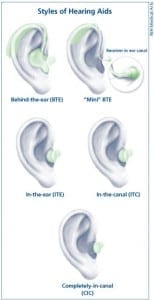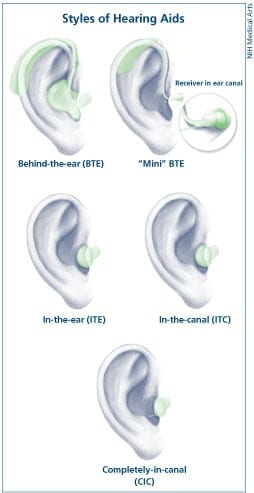
Computer processes sound, filters out background noise for the hearing-impaired
Computer engineers and hearing scientists at The Ohio State University have made a potential breakthrough in solving a 50-year-old problem in hearing technology: how to help the hearing-impaired understand speech in the midst of background noise.
In the Journal of the Acoustical Society of America, they describe how they used the latest developments in neural networks to boost test subjects’ recognition of spoken words from as low as 10 percent to as high as 90 percent.
The researchers hope the technology will pave the way for next-generation digital hearing aids. Such hearing aids could even reside inside smartphones; the phones would do the computer processing, and broadcast the enhanced signal to ultra-small earpieces wirelessly.
Several patents are pending on the technology, and the researchers are working with leading hearing aid manufacturer Starkey, as well as others around the world to develop the technology.
Conquering background noise has been a “holy grail” in hearing technology for half a century, explained Eric Healy, professor of speech and hearing science and director of Ohio State’s Speech Psychoacoustics Laboratory.
The desire to understand one voice in roomful of chatter has been dubbed the “cocktail party problem.”
“Focusing on what one person is saying and ignoring the rest is something that normal-hearing listeners are very good at, and hearing-impaired listeners are very bad at,” Healy said. “We’ve come up with a way to do the job for them, and make their limitations moot.”
Key to the technology is a computer algorithm developed by DeLiang “Leon” Wang, professor of computer science and engineering, and his team. It quickly analyzes speech and removes most of the background noise.
“For 50 years, researchers have tried to pull out the speech from the background noise. That hasn’t worked, so we decided to try a very different approach: classify the noisy speech and retain only the parts where speech dominates the noise,” Wang said.
In initial tests, Healy and doctoral student Sarah Yoho removed twelve hearing-impaired volunteers’ hearing aids, then played recordings of speech obscured by background noise over headphones. They asked the participants to repeat the words they heard. Then they re-performed the same test, after processing the recordings with the algorithm to remove background noise.
They tested the algorithm’s effectiveness against “stationary noise”—a constant noise like the hum of an air conditioner—and then with the babble of other voices in the background.
The algorithm was particularly affective against background babble, improving hearing-impaired people’s comprehension from 25 percent to close to 85 percent on average. Against stationary noise, the algorithm improved comprehension from an average of 35 percent to 85 percent.
The Latest Bing News on:
Hearing technology
- 5 Of The Best Motorcycle Earplugs To Protect Your Hearingon May 9, 2024 at 11:15 pm
Whether you are a new or experienced rider, it's important to protect your ears when going on a cruise. Here are five motorcycle earplugs to consider.
- Music to Your Ears: How the Right Hearing Aid Helps Musicianson May 9, 2024 at 5:30 pm
By Alan Raffauf, Widex USA What do Pete Townshend, Brian Wilson and Ludwig van Beethoven have in common, besides being world-class, world-renown musicians? They all have experienced some form of ...
- Transform lives with Eargo: Accessible hearing solutions for allon May 9, 2024 at 4:07 am
LINK by Eargo: Another new game-changer from Eargo, LINK by Eargo is the first earbud-style OTC hearing aid with Bluetooth 5.3. LINK by Eargo features advanced Bluetooth technology and the new ...
- HearingLife Canada offers customized hearing care technology to make sure you don’t miss a beaton May 8, 2024 at 12:19 pm
“To fully experience the benefits of the revolutionary technology and personalized support that Oticon Intent hearing aids offer, you can take advantage of an at-home 30-day trial,” HearingLife Canada ...
- Charlwood Hearing Care open days to showcase new listening technologyon May 8, 2024 at 9:40 am
LISTENING technology innovations will be showcased at special open days in the region by experts Charlwood Hearing Care. The local, independent, family-run hearing care service, helping people to hear ...
- Modern hearing technology helps ensure you’re tuned in for summer fun in Deltaon May 7, 2024 at 8:00 am
“To fully experience the benefits of the revolutionary technology and personalized support that Oticon Intent hearing aids offer, you can take advantage of an at-home 30-day trial,” says Katie Koebel, ...
- Modern hearing technology helps ensure you’re tuned in for summer fun in Burnabyon May 7, 2024 at 8:00 am
One of many products offered by HearingLife, its mission is to provide discreet and comfortable hearing devices that help enhance quality of life, with modern features such as long-lasting ...
- Modern hearing technology helps ensure you’re tuned in for summer fun in Victoriaon May 7, 2024 at 7:32 am
HearingLife offers modern hearing technology solutions that can recognize this and adjust your settings accordingly, ensuring the conversation comes through clearly while minimizing background noise.
- Hearing Dogs: How They Alert and Assist Individuals with Hearing Losson May 5, 2024 at 8:23 pm
Hearing loss is a common health issue that affects millions of people worldwide. Individuals with hearing loss often face a variety of challenges in their daily lives, including difficulties in ...
- New technology helps North Texas man hear betteron May 3, 2024 at 10:34 am
While hearing aids have been on the market for a while, new technology makes them unlike what’s been around for decades.
The Latest Google Headlines on:
Hearing technology
[google_news title=”” keyword=”hearing technology” num_posts=”10″ blurb_length=”0″ show_thumb=”left”] [/vc_column_text]The Latest Bing News on:
Digital hearing aids
- Music to Your Ears: How the Right Hearing Aid Helps Musicianson May 9, 2024 at 5:30 pm
By Alan Raffauf, Widex USA What do Pete Townshend, Brian Wilson and Ludwig van Beethoven have in common, besides being world-class, world-renown musicians? They all have experienced some form of ...
- 'No choice' but to impeach Biden over delayed Israel aid, GOP senator sayson May 9, 2024 at 7:50 am
A Republican senator is renewing the call to impeach President Biden following reports of aid to Israel being delayed during its war with the terrorist organization Hamas. "The House has no choice but ...
- Pioneering gene therapy restores UK girl's hearingon May 8, 2024 at 4:27 pm
A UK girl born deaf can now hear unaided, after a groundbreaking gene-therapy treatment. Opal Sandy was treated shortly before her first birthday - and six months on, can hear sounds as soft as a ...
- Charlwood Hearing Care open days to showcase new listening technologyon May 8, 2024 at 9:40 am
LISTENING technology innovations will be showcased at special open days in the region by experts Charlwood Hearing Care. The local, independent, family-run hearing care service, helping people to hear ...
- New study finds using hearing aids can reduce risk of death by nearly 25%on May 7, 2024 at 8:38 pm
Researchers hope their findings will inspire action to make hearing aid devices more affordable since they can cost over $1,000 per ear.
- From Hearing Aids to Advanced Scopes: ENT Devices Market Responds to Evolving Healthcare Needs; A Report by TNR, The Niche Researchon May 7, 2024 at 8:00 am
Global ENT Devices Market to Reach Valuation of US$ 49.5 Bn by 2034, Growing at a CAGR of 6.3% During 2024 – 2034Wilmington, Delaware, May 07, 2024 (GLOBE NEWSWIRE) -- The dominance of hearing aids as ...
- Do hearing aids cause tinnitus?on May 6, 2024 at 10:43 am
Let's cut to the chase: No, hearing aids in now way cause tinnitus. In fact, hearing aids are often prescribed as a form of treatment for tinnitus, which sometimes presents alongside hearing loss.
- Completely-In-Canal OTC Hearing Aid: Nearly Invisible Rechargeable Model Updatedon May 3, 2024 at 4:21 pm
Nano Hearing Aids (877-263-8510), one of the leading US makers of over-the-counter (OTC) hearing aids, has updated its popular completely-in-canal (CIC) models. Nano Hearing Aids has announced that ...
- Two years later, over-the-counter hearing aids are still finding their grooveon May 2, 2024 at 7:00 am
Americans have been able to buy over-the-counter hearing aids for almost two years. Have they made a difference? We ask the experts.
- What to do if your BCBS Federal Employee Plan authorization for hearing aids is deniedon May 1, 2024 at 6:01 am
The Tampa Bay Times e-Newspaper is a digital replica of the printed paper seven days a week that is available to read on desktop, mobile, and our app for subscribers only. To enjoy the e-Newspaper ...
The Latest Google Headlines on:
Digital hearing aids
[google_news title=”” keyword=”digital hearing aids” num_posts=”10″ blurb_length=”0″ show_thumb=”left”]











